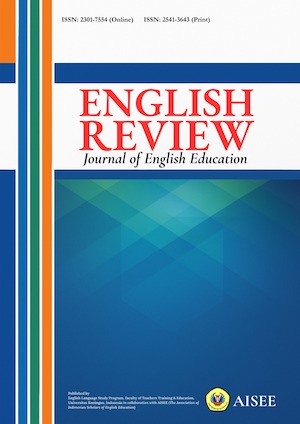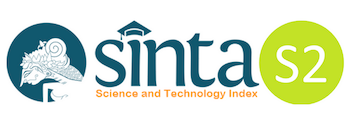ENHANCING INTRINSIC MOTIVATION AND LISTENING SKILLS THROUGH INTEGRATING AUTHENTIC LEARNING MATERIALS
Abstract
Authentic learning materials (ALM) are recognized for providing meaningful and engaging educational experiences. However, there is a lack of extensive research examining the relationship between authentic learning materials, students’ intrinsic motivation, and their listening skills. This study addresses this gap by employing a quantitative method through the distribution of a 35-item Likert scale questionnaire to junior high school students in Batam. The questionnaire aimed to assess students’ attitudes and perceptions regarding the use of authentic materials in their English classes. The results from 30 students indicated that authentic learning materials positively influence student engagement, intrinsic motivation, and cultural awareness. These materials were found to enhance students' interest and participation in learning activities by making the content more relatable and applicable to real-life situations. The study also highlighted some challenges, such as difficulties in comprehension and issues with classroom dynamics, which could impact the overall effectiveness of these materials. Despite these challenges, the data suggest that authentic learning materials effectively bridge the gap between classroom learning and real-world language use. This connection fosters a sense of achievement and satisfaction among students, as they can see the practical application of their language skills. Thus, incorporating authentic materials into the curriculum can provide significant benefits, enhancing the overall learning experience and motivation of students in the English classroom.
References
Adger, C. T., Wolfram, W., & Christian, D. (2014). Dialects in schools and communities. Routledge.
Ahmadi, D. M. R. (2018). The use of technology in English language learning: A literature review. International journal of research in English education, 3(2), 115-125.
Akbari, O., & Razavi, A. (2016). Using authentic materials in the foreign language classrooms: Teachers’ perspectives in EFL classes. International Journal of Research Studies in Education, 5(2), 105-116.
Ashcroft, R. J., Garner, J., & Hadingham, O. (2018). Incidental vocabulary learning through watching movies. Australian Journal of Applied Linguistics, 1(3), 135-147.
Chin, K. Y., Lee, K. F., & Chen, Y. L. (2015). Impact on student motivation by using a QR-based U-learning material production system to create authentic learning experiences. IEEE Transactions on Learning Technologies, 8(4), 367-382.
Chun, D., Kern, R., & Smith, B. (2016). Technology in language use, language teaching, and language learning. The Modern Language Journal, 100(S1), 64-80.
Corbett, J. (2022). An intercultural approach to English language teaching (Vol. 36). Multilingual matters.
DePasque, S., & Tricomi, E. (2015). Effects of intrinsic motivation on feedback processing during learning. NeuroImage, 119, 175-186.
Dörnyei, Z. (1998). Motivation in second and foreign language learning. Language teaching, 31(3), 117-135.
Feng, L., & Papi, M. (2020). Persistence in language learning: The role of grit and future self-guides. Learning and Individual Differences, 81, 101904.
Friesen, N. (2017). The textbook and the lecture: Education in the age of new media. JHU Press.
Gilmore, A. (2007). Authentic materials and authenticity in foreign language learning. Language teaching, 40(2), 97-118.
Goh, C. C., & Vandergrift, L. (2021). Teaching and learning second language listening: Metacognition in action. Routledge.
Gulnaz, F., Ahmad, A., & Mandouh, S. Y. (2015). An exploration of the demotivational factors affecting teaching and learning of English as a foreign language of EFL learners in Gulf countries. People, 2(1), 17-32.
Kim, H. S. (2015). Using Authentic Videos to Improve EFL Students' Listening Comprehension. International journal of contents, 11(4).
Malone, T. W., & Lepper, M. R. (2021). Making learning fun: A taxonomy of intrinsic motivations for learning. In Aptitude, learning, and instruction (pp. 223-254). Routledge.
Mercer, S., & Dörnyei, Z. (2020). Engaging language learners in contemporary classrooms. Cambridge University Press.
Mishan, F. (2015). Materials development for TESOL. Edinburgh University Press.
Newton, J. M., & Nation, I. S. (2020). Teaching ESL/EFL listening and speaking. Routledge.
Pinner, R. (2014). The authenticity continuum: Towards a definition incorporating international voices: Why authenticity should be represented as a continuum in the EFL classroom. English today, 30(4), 22-27.
Shahid, S. H., & Ali, Z. (2017). Effects of video-podcasts on listening comprehension of Saudi EFL learners. European Journal of English Language Teaching.
Sotlikova, R., & Haerazi, H. (2023). Students’ perceptions towards the use of podcasts in EFL classroom: A case study at a University of Uzbekistan. Journal of Languages and Language Teaching, 11(3), 461-474.
Thohir, L. (2017). Motivation in a foreign language teaching and learning. Vision: Journal for language and foreign language learning, 6(1), 20-29.
Tilwani, S. A., Vadivel, B., Uribe-Hernández, Y. C., Wekke, I. S., & Haidari, M. M. F. (2022). The impact of using TED talks as a learning instrument on enhancing Indonesian EFL learners’ listening skill. Education Research International, 2022, 1-9.
Tomlinson, B. (2012). Materials development for language learning and teaching. Language teaching, 45(2), 143-179.
Tomlinson, B. (Ed.). (2023). Developing materials for language teaching. Bloomsbury Publishing.
Tomlinson, B., & Masuhara, H. (2017). The complete guide to the theory and practice of materials development for language learning. John Wiley & Sons.
Wu, Y. T., Foong, L. Y. Y., & Alias, N. (2022). Motivation and Grit Affects Undergraduate Students' English Language Performance. European Journal of Educational Research, 11(2), 781-794.
Yıldırım, S., & Yıldırım, Ö. (2016). The importance of listening in language learning and listening comprehension problems experienced by language learners: A literature review. Abant İzzet Baysal Üniversitesi Eğitim Fakültesi Dergisi, 16(4), 2094-2110.
All articles published in English Review: Journal of English Education (ERJEE) are licensed under the Creative Commons Attribution 4.0 International License (CC BY 4.0).
Copyright Ownership
Authors retain the copyright of their articles and grant ERJEE the right of first publication. The journal is granted a non-exclusive license to publish, reproduce, and distribute the article in any format, medium, or platform, provided that proper credit is given to the original authors.
License Terms – CC BY 4.0
Under the Creative Commons Attribution 4.0 International License, others are free to:
- Share — copy and redistribute the material in any medium or format
- Adapt — remix, transform, and build upon the material for any purpose, even commercially
As long as they:
- Provide appropriate credit to the original author(s) and source
- Provide a link to the license (https://creativecommons.org/licenses/by/4.0/)
- Indicate if any changes were made
There are no restrictions on the reuse, reproduction, or adaptation of published articles as long as attribution is properly given.
Author Warranties
By submitting a manuscript to ERJEE, authors confirm that:
- The work is original and does not infringe any existing copyright.
- The manuscript has not been previously published and is not under consideration elsewhere.
- All sources and references are appropriately acknowledged.
- Necessary permissions have been obtained for any copyrighted materials used.









